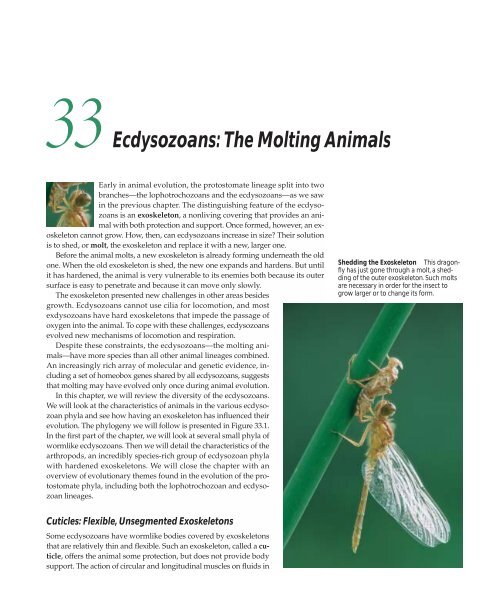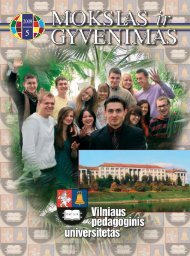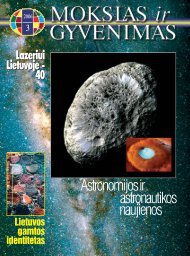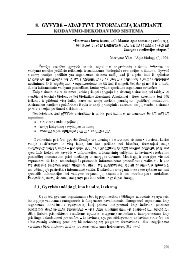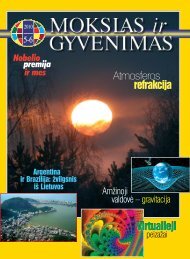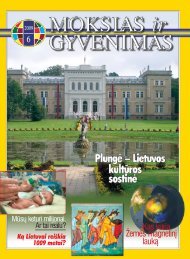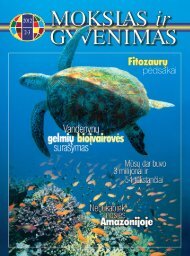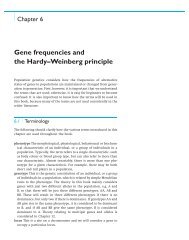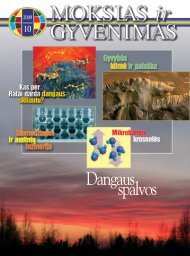Ecdysozoans: The Molting Animals - Laboratory of Visual Systems
Ecdysozoans: The Molting Animals - Laboratory of Visual Systems
Ecdysozoans: The Molting Animals - Laboratory of Visual Systems
Create successful ePaper yourself
Turn your PDF publications into a flip-book with our unique Google optimized e-Paper software.
ECDYSOZOANS: THE MOLTING ANIMALS 645manipulated by muscles. Such appendages evolved severaltimes in the late Precambrian, leading to the lineages collectivelycalled the arthropods (“jointed foot”). Divisions amongthe arthropod lineages are ancient and have been the subject<strong>of</strong> much research in the past decade. <strong>The</strong>se phylogenetic relationshipsare being examined daily in the light <strong>of</strong> a wealth<strong>of</strong> new information, much <strong>of</strong> it concerning gene expression.<strong>The</strong>re is currently no consensus on an exact phylogeny, butmost researchers agree that these important animal groupsare monophyletic, and some taxonomists consider them asmembers <strong>of</strong> a single phylum: Arthropoda.Before presenting one current view <strong>of</strong> arthropod phylogeny,let’s look at some arthropod relatives that have segmentedbodies but unjointed legs, and at an early arthropodlineage that disappeared but left an important fossil record.Some relatives <strong>of</strong> the arthropods have unjointed legsAlthough they were onceKinorhynchathought to be closely relatedPriapulidato annelid worms, recentChaetognathamolecular evidence linksNematomorphathe 110 species <strong>of</strong> onychophorans(phylum Ony-NematodaOnychophorachophora) to the arthropodTardigradalineages. Onychophorans haveCrustaceas<strong>of</strong>t bodies that are covered by athin, flexible cuticle that containsHexapodachitin. Onychophorans use their fluidfilledbody cavities as hydrostatic skeletons.ChelicerataMyriapoda<strong>The</strong>ir s<strong>of</strong>t, fleshy, unjointed, claw-bearing legs areformed by outgrowths <strong>of</strong> the body (Figure 33.6a). <strong>The</strong>se animalsare probably similar in appearance to ancestral arthropods.Fertilization is internal, and the large, yolky eggs arebrooded with the body <strong>of</strong> the female.Like the onychophorans, water bears (phylum Tardigrada)have fleshy, unjointed legs and use their fluid-filledbody cavities as hydrostatic skeletons (Figure 33.6b). Waterbears are extremely small (0.1–0.5 mm in length), and theylack circulatory systems and gas exchange organs. <strong>The</strong> 600extant species <strong>of</strong> water bears live in marine sands and ontemporary water films on plants. When these films dry out,the water bears also lose water and shrink to small, barrelshapedobjects that can survive for at least a decade in a dormantstate. <strong>The</strong>y have been found at densities as high as 2million per square meter <strong>of</strong> moss.Jointed legs appeared in the trilobites<strong>The</strong> trilobites (phylum Trilobita) were among the earliestarthropods. <strong>The</strong>y flourished in Cambrian and Ordovicianseas, but disappeared in the great Permian extinction at theclose <strong>of</strong> the Paleozoic era (245 mya). Because their heavy exoskeletonsprovided ideal material for fossilization, they leftbehind an abundant record <strong>of</strong> their existence (Figure 33.7).Trilobites were heavily armored, and their body segmentationand appendages followed a relatively simple, repetitiveplan. But their appendages were jointed, and some <strong>of</strong>them were modified for different functions. This specialization<strong>of</strong> appendage function became a theme as the evolution<strong>of</strong> the arthropod lineage continued.Modern arthropods dominate Earth’s faunaArthropod appendages have evolved an amazing variety <strong>of</strong>forms, and they serve many functions, including walkingand swimming, gas exchange, food capture and manipulation,copulation, and sensory perception. <strong>The</strong> pattern <strong>of</strong> segmentationis similar among most arthropods because theirdevelopment is governed by a common cascade <strong>of</strong> regula-(a) Peripatus sp.33.6 Unjointed Legs (a) Onychophorans, also called “velvet worms,”have unjointed legs and use the body cavity as a hydrostatic skeleton.(b) <strong>The</strong> appendages and general anatomy <strong>of</strong> water bears superficiallyresemble those <strong>of</strong> onychophorans.(b) Echiniscus springer 50 µm
646 CHAPTER THIRTY-THREEOdontochile rugosa33.7 A Trilobite <strong>The</strong> relatively simple, repetitive segments <strong>of</strong> thenow-extinct trilobites are illustrated by a fossil trilobite from the shallowseas <strong>of</strong> the Devonian period, some 400 million years ago.tory genes (see Figure 19.15), including homeotic genes thatdetermine the kinds <strong>of</strong> appendages that are borne on eachsegment.Kinorhyncha<strong>The</strong> bodies <strong>of</strong> arthropodsare divided into segments.Priapulida<strong>The</strong>ir muscles are attachedto the inside <strong>of</strong>NematomorphaChaetognathathe exoskeleton. Each segmenthas muscles that op-OnychophoraNematodaerate that segment and theTardigradaappendages attached to it (Figure33.8). <strong>The</strong> arthropod exo-CrustaceaHexapodaskeleton has had a pr<strong>of</strong>ound influenceon the evolution <strong>of</strong> these animals.MyriapodaChelicerataEncasement within a rigid body covering providessupport for walking on dry land, and the waterpro<strong>of</strong>ingprovided by chitin keeps the animal from dehydrating indry air. Aquatic arthropods were, in short, excellent candidatesto invade terrestrial environments. As we will see, theydid so several times.<strong>The</strong>re are four major arthropod phyla living today: thecrustaceans, hexapods (insects), myriapods, and chelicerates.Collectively, the arthropods (including both terrestrial andmarine species) are the dominant animals on Earth, both innumbers <strong>of</strong> species (about 1.5 million described) and number<strong>of</strong> individuals (estimated at some 10 18 individuals, or abillion billion).Crustaceans (phylum Crustacea) are the dominant marinearthropods today. <strong>The</strong> most familiar crustaceans belong to theclass Malacostraca, which includes shrimp, lobsters, crayfish,and crabs (decapods; Figure 33.9a); and sow bugs (isopods;Figure 33.9b). Also included among the crustaceans are a variety<strong>of</strong> small species, many <strong>of</strong> which superficially resembleshrimp. <strong>The</strong> individuals <strong>of</strong> one group alone, the copepods(class Copepoda; Figure 33.9c), are so numerous that theymay be the most abundant <strong>of</strong> all animals.Barnacles (class Cirripedia) are unusual crustaceans that aresessile as adults (Figure 33.9d). With their calcareous shells,they superficially resemble mollusks but, as the zoologist LouisAgassiz remarked more than a century ago, a barnacle is“nothing more than a little shrimp-like animal, standing on itshead in a limestone house and kicking food into its mouth.”Most <strong>of</strong> the 40,000 described species <strong>of</strong> crustaceans havea body that is divided into three regions: head, thorax, and abdomen.<strong>The</strong> segments <strong>of</strong> the head are fused together, and thehead bears five pairs <strong>of</strong> appendages. Each <strong>of</strong> the multiplethoracic and abdominal segments usually bears one pair <strong>of</strong>appendages. In some cases, the appendages are branched,with different branches serving different functions. In manyspecies, a fold <strong>of</strong> the exoskeleton, the carapace, extends dorsallyand laterally back from the head to cover and protectsome <strong>of</strong> the other segments (Figure 33.10a).<strong>The</strong> fertilized eggs <strong>of</strong> most crustacean species are attachedto the outside <strong>of</strong> the female’s body, where they remain duringtheir early development. At hatching, the young <strong>of</strong> somespecies are released as larvae; those <strong>of</strong> other species are releasedas juveniles that are similar in form to the adults. Stillother species release eggs into the water or attach them to anobject in the environment. <strong>The</strong> typical crustacean larva, calleda nauplius, has three pairs <strong>of</strong> appendages and one centraleye (Figure 33.10b). In many crustaceans, the nauplius larvadevelops within the egg before it hatches.<strong>The</strong>re is a growing recognition among researchers that acrustacean lineage may have been ancestral to all present-dayarthropods. <strong>The</strong>refore, the phylum Crustacea, as we recognizeit here, may be paraphyletic (see Chapter 25). Molecularevidence points especially to a link between the crustaceansand another important lineage, the hexapods.Exoskeleton(cuticle)HemocoelHeartLongitudinal muscleDorsoventral muscleMuscles thatmove appendageCrustaceans: Diverse and AbundantLongitudinalmuscleVentralnerve cordMuscleswithinappendage33.8 Arthropod Exoskeletons Are Rigid and Jointed This crosssection through a thoracic segment <strong>of</strong> a generalized arthropod illustratesthe arthropod body plan, which is characterized by a rigidexoskeleton with jointed appendages.
ECDYSOZOANS: THE MOLTING ANIMALS 647(a) Opisthopus transversus(c) Cyclops sp.(b) Ligia occidentalis33.9 Crustacean Diversity (a) This mottled pea crab is a decapodcrustacean. Its pigmentation depends on the food it ingests. (b) Thisisopod is found on the beaches <strong>of</strong> the California coast. (c) This microscopicfreshwater copepod is only about 30 µm long. (d) Gooseneckbarnacles attach to a substratum and feed by protruding and retractingfeeding appendages from their shells.(d) Lepas pectinataInsects: Terrestrial Descendants<strong>of</strong> Marine CrustaceansDuring the Devonian, more than 400 million years ago,arthropods made the leap from the marine environment ontoland. Of the several groups who successfully colonized the(a)AbdomenCarapace coveringhead and thorax(b)Mediancompound eyeterrestrial habitat, none is more prominent today than the sixleggedindividuals <strong>of</strong> the phylum Hexapoda—the insects.Insects are found in most terrestrial and freshwater habitats,and they utilize nearly all species <strong>of</strong> plants and manyspecies <strong>of</strong> animals as food. Some are internal parasites <strong>of</strong>plants and animals; others suck their host’s blood or consumesurface body tissues. <strong>The</strong> 1.4 million species <strong>of</strong> insectsthat have been described are believed to be only a small fraction<strong>of</strong> the total number <strong>of</strong> species living today.AntennuleAppendages are specialized for chewing,sensing, walking, and swimming.AntennaMandible33.10 Crustacean Structure(a) <strong>The</strong> bodies <strong>of</strong> crustaceans aredivided into three regions, each <strong>of</strong>which bears appendages. (b) Anauplius larva has one compoundeye and three pairs <strong>of</strong> appendages.
648 CHAPTER THIRTY-THREEVery few insect species live in the ocean. In freshwater environments,on the other hand, they are sometimes the dominantanimals, burrowing through the substratum, extractingsuspended prey from the water, and actively pursuing otheranimals. Insects were the first animals to achieve the abilityto fly, and they are important pollinators <strong>of</strong> flowering plants.Insects, like crustaceans, have three basic body regions:head, thorax, and abdomen. <strong>The</strong>y have a single pair <strong>of</strong> antennaeon the head and three pairs <strong>of</strong> legs attached to the thorax(Figure 33.11). Unlike the other arthropods, insects haveno appendages growing from their abdominal segments (seeFigure 21.5).An insect exchanges gases by means <strong>of</strong> air sacs and tubularchannels called tracheae (singular, trachea) that extendfrom external openings inward to tissues throughout thebody. <strong>The</strong> adults <strong>of</strong> most flying insects have two pairs <strong>of</strong> stiff,membranous wings attached to the thorax. However, flieshave only one pair <strong>of</strong> wings, and in beetles the forewingsform heavy, hardened wing covers.Wingless insects include springtails and silverfish (Figure33.12). Of the modern insects, they are probably the mostsimilar in form to insect ancestors. Apterygote insects have asimple life cycle, hatching from eggs as miniature adults.Development in the winged insects (Figure 33.13) is complex.<strong>The</strong> hatchlings do not look like adults, and they undergosubstantial changes at each molt. <strong>The</strong> immature stages<strong>of</strong> insects between molts are called instars. A substantialchange that occurs between one developmental stage and anotheris called metamorphosis. If the changes between its instarsare gradual, an insect is said to have incomplete metamorphosis.Head Thorax AbdomenHydropodura aquaticaIn some insect groups, the larval and adult forms appearto be completely different animals. <strong>The</strong> most familiar example<strong>of</strong> such complete metamorphosis occurs in members <strong>of</strong>the order Lepidoptera, in which the larval caterpillar transformsitself into the adult butterfly (see Figure 1.1). Duringcomplete metamorphosis, the wormlike larva transforms itselfduring a specialized phase, called the pupa, in whichmany larval tissues are broken down and the adult form develops.In many <strong>of</strong> these groups, the different life stages arespecialized for living in different environments and using differentfood sources. In many species, the larvae are adaptedfor feeding and growing, and the adults are specialized forreproduction and dispersal.Entomologists divide the winged insects into about 29 differentorders. We can make sense <strong>of</strong> this bewildering varietyby recognizing three major lineages:33.12 Wingless Insects<strong>The</strong> wingless insects have asimple life cycle. <strong>The</strong>y hatchlooking like miniature adults,then grow by successivemoltings <strong>of</strong> the cuticles asthese springtails are doing.Winged insects that cannot fold their wings against thebodyWinged insects that can fold their wings and that undergoincomplete metamorphosisWinged insects that can fold their wings and that undergocomplete metamorphosisExoskeletonBrainWingsDorsalcirculatoryvesselsExcretory organsBecause they can fold their wings over their backs, flying insectsbelonging to the second and third lineages can tucktheir wings out <strong>of</strong> the way upon landing and crawl intocrevices and other tight places.AntennaVentralnerve cordTracheaGutTestisAnus33.11 Structure <strong>of</strong> an Insect This diagram <strong>of</strong> a generalized insectillustrates its three-part body plan. <strong>The</strong> middle region, the thorax,bears three pairs <strong>of</strong> legs and, in most groups, two pairs <strong>of</strong> wings.33.13 <strong>The</strong> Diversity <strong>of</strong> Insects (a) Unlike most flying insects,this dragonfly cannot fold its wings over its back. (b) <strong>The</strong> Mexicanbush katydid represents the order Orthoptera. (c) Harlequin bugs are“true” bugs (order Hemiptera); (d) <strong>The</strong>se mating mantophasmatodeansrepresent a recently discovered Hemipteran lineage foundonly in the Cape region <strong>of</strong> South Africa. (e) A predatory diving beetle(order Coleoptera). (f) <strong>The</strong> California dogface butterfly is a member <strong>of</strong>the Lepidoptera. (g) <strong>The</strong> flies, including this Mediterranean fruit fly,comprise the order Diptera. (h) Many genera in the orderHymenoptera, such as honeybees, are social insects.▲
(a) Anax imperator(e) Dytiscus marginalis(b) Scudderia mexicana( f ) Colias eurydice(c) Murgantia histrionica(g) Ceratitis capitata(d) Timema sp.(h) Apis mellifera
650 CHAPTER THIRTY-THREE<strong>The</strong> only surviving members <strong>of</strong> the lineage whose memberscannot fold their wings against the body are the ordersOdonata (dragonflies and damselflies, Figure 33.13a) andEphemeroptera (mayflies). All members <strong>of</strong> these two ordershave aquatic larvae that transform themselves into flyingadults after they crawl out <strong>of</strong> the water. Although many <strong>of</strong>these insects are excellent flyers, they require a great deal <strong>of</strong>open space in which to maneuver. Dragonflies and damselfliesare active predators as adults, but adult mayflies lackfunctional digestive tracts and live only long enough to mateand lay eggs.<strong>The</strong> second lineage, whose members can fold their wingsand have incomplete metamorphosis, includes the orders Orthoptera(grasshoppers, crickets, roaches, mantids, and walkingsticks; Figure 33.13b), Isoptera (termites), Plecoptera(stone flies), Dermaptera (earwigs), Thysanoptera (thrips),Hemiptera (true bugs; Figure 33.13c), and Homoptera(aphids, cicadas, and leafhoppers). In these groups, hatchlingsare sufficiently similar in form to adults to be recognizable.<strong>The</strong>y acquire adult organ systems, such as wings andcompound eyes, gradually through several juvenile instars.Remarkably, a new insect order in this lineage, the Mantophasmatodea,was first described in 2002 (Figure 33.13d).<strong>The</strong>se small insects are common in the Cape Region <strong>of</strong> southernAfrica, an area <strong>of</strong> exceptional species richness and endemismfor many animal and plant groups.Insects belonging to the third lineage undergo completemetamorphosis. About 85 percent <strong>of</strong> all species <strong>of</strong> winged insectsbelong to this lineage. Familiar examples are the ordersNeuroptera (lacewings and their relatives), Coleoptera (beetles;Figure 33.13e), Trichoptera (caddisflies), Lepidoptera(butterflies and moths; Figure 33.13f), Diptera (flies; Figure33.13g), and Hymenoptera (sawflies, bees, wasps, and ants;Figure 33.13h).Members <strong>of</strong> several orders <strong>of</strong> winged insects, includingthe Phthiraptera (lice) and Siphonaptera (fleas), are parasitic.Although descended from flying ancestors, these insects havelost the ability to fly.Molecular data suggest that the lineage leading to the insectsseparated from the lineage leading to modern crustaceansabout 450 million years ago, about the time <strong>of</strong> the appearance<strong>of</strong> the first land plants. <strong>The</strong>se ancestral forms penetrated a terrestrialenvironment that was ecologically empty, which in partaccounts for their remarkable success. But this success <strong>of</strong> theinsects is also due to their wings, which arose only once earlyduring insect evolution. Homologous genes control the development<strong>of</strong> insect wings and crustacean appendages, suggestingthat that the insect wing evolved from a dorsal branch<strong>of</strong> a crustacean limb (Figure 33.14). <strong>The</strong> dorsal limb branch <strong>of</strong>crustaceans is used for respiration and osmoregulation. Thisfinding suggests that the insect wing evolved from a gill-likestructure that had a respiratory function.Development <strong>of</strong> appendagesin the crayfish isgoverned by the pdm gene.(a) AncestralmultibranchedappendageDorsalbranches(b) Modern crayfishArthropods with Two Body RegionsDevelopment <strong>of</strong> the insectwing is governed by theexpression <strong>of</strong> the same gene.pdm gene product(c) DrosophilaWingInsects and most crustaceans have tripartite body plans,with a head, thorax, and abdomen. In two other arthropodlineages, evolution resulted in a body plan with two regions—ahead and a trunk.Myriapods have many legsCentipedes, millipedes, and the two other groups <strong>of</strong> animalscomprise the phylum Myriapoda. Centipedes and millipedeshave a well-formed head and a long, flexible, segmentedtrunk that bears many pairs <strong>of</strong> legs (Figure 33.15). Centipedes,which have one pair <strong>of</strong> legs per segment, prey on insectsand other small animals. Millipedes, which have twopairs <strong>of</strong> legs per segment, scavenge and eat plants. More than3,000 species <strong>of</strong> centipedes and 10,000 species <strong>of</strong> millipedeshave been described; many more species probably remainunknown. Although most myriapods are less than a few centimeterslong, some tropical species are ten times that size.Most chelicerates have four pairs <strong>of</strong> walking legsIn the body plan <strong>of</strong> chelicerates (phylum Chelicerata), the anteriorregion (head) bears two pairs <strong>of</strong> appendages modifiedto form mouthparts. In addition, many chelicerates have fourpairs <strong>of</strong> walking legs. <strong>The</strong> 63,000 described chelicerate speciesare usually placed in three classes: Pycnogonida, Merostomata,and Arachnida; most <strong>of</strong> them belong to Arachnida.<strong>The</strong> pycnogonids (class Pycnogonida), or sea spiders, area poorly known group <strong>of</strong> about 1,000 marine species (Figure33.16a). Most are small, with leg spans less than 1 cm, butsome deep-sea species have leg spans up to 60 cm. A few py-Leg33.14 Origin <strong>of</strong> Insect Wings <strong>The</strong> insect wing may have evolvedfrom an ancestral appendage similar to that <strong>of</strong> modern crustaceans.(a) A diagram <strong>of</strong> the ancestral, multibranched arthropod limb. (b, c)<strong>The</strong> pdm gene, a Hox gene, is expressed throughout the dorsal limbbranch and walking leg <strong>of</strong> the thoracic limb <strong>of</strong> a crayfish (a) and inthe wings and legs <strong>of</strong> Drosophila (b).
ECDYSOZOANS: THE MOLTING ANIMALS 65133.15 Myriapods(a) Centipedes have powerfuljaws for capturing active prey.(b) Millipedes, which are scavengersand plant eaters, havesmaller jaws and legs. <strong>The</strong>yhave two pairs <strong>of</strong> legs per segment,in contrast to the onepair on each segment <strong>of</strong> centipedes.(b) Harpaphe haydeniana(a) Scolopendra heroscnogonids feed on algae, but most are carnivorous, feedingon a variety <strong>of</strong> small invertebrates.<strong>The</strong> class Merostomata contains the horseshoe crabs (orderXiphosura), with five living species, and the extinct giantwater scorpions (order Eurypterida). Horseshoe crabs, whichhave changed very little during their long fossil history, havea large horseshoe-shaped covering over most <strong>of</strong> the body.<strong>The</strong>y are common in shallow waters along the eastern coasts<strong>of</strong> North America and Southeast Asia, where they scavengeand prey on bottom-dwelling invertebrates. Periodically theycrawl into the intertidal zone in large numbers to mate andlay eggs (Figure 33.16b).Arachnids (class Arachnida) are abundant in terrestrialenvironments. Most arachnids have a simple life cycle inwhich miniature adults hatch from internally fertilized eggsand begin independent lives almost immediately. Somearachnids retain their eggs during development and givebirth to live young.<strong>The</strong> most species-rich and abundant arachnids are the spiders,scorpions, harvestmen, mites, and ticks (Figure 33.17).<strong>The</strong> 30,000 described species <strong>of</strong> mites and ticks live in soil,leaf litter, mosses, and lichens, under bark, and as parasites<strong>of</strong> plants, invertebrates, and vertebrates. <strong>The</strong>y are vectors forwheat and rye mosaic viruses, and they cause mange in domesticanimals and skin irritation in humans.Spiders are important terrestrial predators. Some have excellentvision that enables them to chase and seize their prey.Others spin elaborate webs made <strong>of</strong> protein threads in whichthey snare prey. <strong>The</strong> threads are produced by modified abdominalappendages connected to internal glands that secretethe proteins, which dry on contact with air. <strong>The</strong> webs <strong>of</strong>different groups <strong>of</strong> spiders are strikingly varied, and this variationenables the spiders to position their snares in many differentenvironments. Spiders also use protein threads to constructsafety lines during climbing and as homes, mating(a) Decalopoda sp.33.16 Minor Chelicerate Phyla (a) Although they are not spiders,it is easy to see why sea spiders were given their common name.(b) This spawning aggregation <strong>of</strong> horseshoe crabs was photographedon a sandy beach in Delaware.(b) Limulus polyphemus
652 CHAPTER THIRTY-THREE(a) Phidippus formosus(b) Pseudouroctonus minimus(c) Hadrobunus maculosusstructures, protection for developing young, and means <strong>of</strong>dispersal.<strong>The</strong>mes in the Evolution <strong>of</strong> ProtostomesWe end this chapter by reviewing some <strong>of</strong> the evolutionarytrends we have seen in the animal groups we have discussedso far. Most <strong>of</strong> protostomate evolution took place in theoceans. Early protostomes used their fluid-filled body cavitiesas hydrostatic skeletons. Segmentation permitted differentparts <strong>of</strong> the body to be moved independently <strong>of</strong> one another.Thus species in some protostomate lineages graduallyevolved the ability to change their shape in complex waysand to move rapidly over and through the substratum orthrough the water.During much <strong>of</strong> animal evolution, the only food in the waterconsisted <strong>of</strong> dissolved organic matter and very small organisms.Consequently, many different lineages <strong>of</strong> animals,including lophophorates, mollusks, tunicates, and some crustaceans,evolved feeding structures designed to filter smallprey from water, as well as structures for moving water(d) Brevipalpus phoenicis33.17 Arachnid Diversity (a) <strong>The</strong> black jumping spider’s bite producesan inflammatory reaction on mammalian skin. (b) Scorpionsare nocturnal predators. (c) Harvestmen, also called daddy longlegs,are scavengers. (d) Mites are blood-sucking, external parasites on vertebrates.through or over their prey-collecting devices. <strong>Animals</strong> thatfeed in this manner are abundant and widespread in marinewaters today.Because water flows readily, bringing food with it, sessilelifestyles also evolved repeatedly during lophotrochozoanand ecdysozoan evolution. Most phyla today have at leastsome sessile members. Being sessile presents certain challenges.For example, sessile animals cannot come together tomate. Some species eject both eggs and sperm into the water;others retain their eggs within their bodies and extrude onlytheir sperm, which are carried by the water to other individuals.Species whose adults are sessile <strong>of</strong>ten have motile larvae,many <strong>of</strong> which have complicated mechanisms for locatingsuitable sites on which to settle.A sessile animal gains access to local resources, but forfeitsaccess to more distant resources. Many colonial sessile pro-
33.1Anatomical Characteristics <strong>of</strong> the Major Protostomate PhylaCIRCULATORYPHYLUM BODY CAVITY DIGESTIVE TRACT SYSTEMLophotrochozoansPlatyhelminthes None Dead-end sac NoneRotifera Pseudocoelom Complete NoneBryozoa Coelom Complete NoneBrachiopoda Coelom Complete in most OpenPhoronida Coelom Complete ClosedNemertea Coelom Complete ClosedAnnelida Coelom Complete Closed or openMollusca Reduced coelom Complete Open except incephalopods<strong>Ecdysozoans</strong>Chaetognatha Coelom Complete NoneNematomorpha Pseudocoelom Greatly reduced NoneNematoda Pseudoceolom Complete NoneCrustacea Hemocoel Complete OpenHexapoda Hemocoel Complete OpenMyriapoda Hemocoel Complete OpenChelicerata Hemocoel Complete OpenNote: All protostomes have bilateral symmetry.tostomes, however, are able to grow in the direction <strong>of</strong> betterresources or into sites <strong>of</strong>fering better protection. Individualmembers <strong>of</strong> colonies, if they are directly connected, can shareresources. <strong>The</strong> ability to share resources enables some individualsto specialize for particular functions, such as reproduction,defense, or feeding. <strong>The</strong> nonfeeding individuals derivetheir nutrition from their feeding associates.Predation may have been the major selective pressure forthe development <strong>of</strong> hard, external body coverings. Such coveringsevolved independently in many lophotrochozoan andecdysozoan lineages. In addition to providing protection,they became key elements in the development <strong>of</strong> new systems<strong>of</strong> locomotion. Locomotory abilities permitted prey toescape more readily from predators, but also allowed predatorsto pursue their prey more effectively. Thus, the evolution<strong>of</strong> animals has been, and continues to be, a complex“arms race” among predators and prey.Although we have concentrated on the evolution <strong>of</strong>greater complexity in animal lineages, many lineages whosemembers have remained simple have been very successful.Cnidarians are common in the oceans; roundworms areabundant in most aquatic and terrestrial environments. Parasiteshave lost complex body plans but have evolved complexlife cycles.<strong>The</strong> characteristics <strong>of</strong> the major existing phyla <strong>of</strong> protostomateanimals are summarized in Table 33.1. Many majorevolutionary trends were shared by protostomes anddeuterostomes, the lineage that includes the chordates, theECDYSOZOANS: THE MOLTING ANIMALS 653group to which humans belong. We willconsider the evolution <strong>of</strong> diversity amongthe deuterostomes in the next chapter.Chapter Summary <strong>The</strong> ecdysozoan lineage is characterized bya nonliving external covering—an exoskeleton,or cuticle. Review Figure 33.1 An animal with an exoskeleton grows byperiodically shedding its exoskeleton andreplacing it with a larger one, a process calledmolting.Cuticles: Flexible, UnsegmentedExoskeletons Members <strong>of</strong> several phyla <strong>of</strong> marine wormswith thin cuticles are descendants <strong>of</strong> an earlysplit in the ecdysozoan lineage. ReviewFigure 33.3 Tough cuticles are found in members <strong>of</strong>two phyla, the horsehair worms and theroundworms. Roundworms (phylum Nematoda) are one<strong>of</strong> the most abundant and universally distributed<strong>of</strong> all animal groups. Many are parasites.Review Figure 33.5Arthropods and <strong>The</strong>ir Relatives:Segmented External Skeletons <strong>Animals</strong> with rigid exoskeletons lack cilia for locomotion. Tomove, they have appendages that can be manipulated by muscles.Review Figure 33.8 Although there is currently no consensus on an exact phylogeny,most researchers agree that the arthropod groups aremonophyletic. Onychophorans and tardigrades have s<strong>of</strong>t, unjointed legs.<strong>The</strong>y are probably similar to ancestral arthropods. Trilobites flourished in Cambrian and Ordovician seas, butthey became extinct at the close <strong>of</strong> the Paleozoic era.Crustaceans: Species-Rich and Abundant <strong>The</strong> segments <strong>of</strong> the crustacean body are divided amongthree regions: head, thorax, and abdomen. Review Figure 33.10 <strong>The</strong> most familiar crustaceans are shrimp, lobsters, crayfish,crabs, sow bugs, and sand fleas. Copepod crustaceans may bethe most abundant animals on the planet. Recent molecular evidence indicates that the crustacean lineagemay be ancestral to all the arthropods.Insects: Terrestrial Descendants <strong>of</strong> Marine Crustaceans About 1.4 million species <strong>of</strong> insects (phylum Hexapoda) havebeen described, but that number is a small fraction <strong>of</strong> the totalnumber <strong>of</strong> existing species. Although few species are found inmarine environments, they are among the dominant animals invirtually all terrestrial and many freshwater habitats. Like crustaceans, insects have three body regions (head, thorax,abdomen). <strong>The</strong>y bear a single pair <strong>of</strong> antennae on the headand three pairs <strong>of</strong> legs attached to the thorax. No appendagesgrow from their abdominal segments. Review Figure 33.11 Wingless insects look like miniature adults when they hatch.Hatchlings <strong>of</strong> some winged insects resemble adults, but othersundergo substantial changes at each molt.
654 CHAPTER THIRTY-THREE <strong>The</strong> winged insects can be divided into three major subgroups.Members <strong>of</strong> one subgroup cannot fold their wings backagainst the body. Members <strong>of</strong> the other two subgroups can. <strong>The</strong> wings <strong>of</strong> insects probably evolved from the dorsalbranches <strong>of</strong> multibranched ancestral appendages. ReviewFigure 33.14Arthropods with Two Body Regions Individuals <strong>of</strong> the remaining arthropod phyla generally havesegmented bodies with two distinct regions, head and trunk. Myriapods (centipedes and millipedes) have many segmentsand many pairs <strong>of</strong> legs. Most chelicerates (phylum Chelicerata) have four pairs<strong>of</strong> legs. Arachnids—scorpions, harvestmen, spiders, mites, andticks—are abundant in terrestrial environments.<strong>The</strong>mes in the Evolution <strong>of</strong> Protostomes Most evolution <strong>of</strong> protostomes took place in the oceans. Early animals used fluid-filled body cavities as hydrostaticskeletons. Subdivision <strong>of</strong> the body cavity into segments allowedbetter control <strong>of</strong> movement. During much <strong>of</strong> animal evolution, the only food in the waterconsisted <strong>of</strong> dissolved organic matter and very small organisms. Flowing water brings food with it, allowing many aquaticanimals to obtain food while being sessile. Predation may have been the major selective pressure for thedevelopment <strong>of</strong> hard, external body coverings.See Web/CD Activities 33.1 and 33.2 for a concept review <strong>of</strong>this chapter.Self-Quiz1. <strong>The</strong> outer covering <strong>of</strong> ecdysozoansa. is always hard and rigid.b. is always thin and flexible.c. is present at some stage in the life cycle but not alwaysamong adults.d. ranges from very thin to hard and rigid.e. prevents the animals from changing their shapes.2. <strong>The</strong> primary support for members <strong>of</strong> several small phyla <strong>of</strong>marine worms isa. their exoskeletons.b. their internal skeletons.c. their hydrostatic skeletons.d. the surrounding sediments.e. the bodes <strong>of</strong> other animals within which they live.3. Roundworms are abundant and diverse becausea. they are both parasitic and free-living and eat a wide variety<strong>of</strong> foods.b. they are able to molt their exoskeletons.c. their thick cuticle enables them to move in complex ways.d. their body cavity is a pseudocoelom.e. their segmented bodies enable them to live in many differentplaces.4. <strong>The</strong> arthropod exoskeleton is composed <strong>of</strong> aa. mixture <strong>of</strong> several kinds <strong>of</strong> polysaccharides.b. mixture <strong>of</strong> several kinds <strong>of</strong> proteins.c. single complex polysaccharide called chitin.d. single complex protein called arthropodin.e. mixture <strong>of</strong> layers <strong>of</strong> proteins and a polysaccharide calledchitin.5. Which phyla are arthropod relatives with unjointed legs?a. Trilobita and Onychophorab. Onychophora and Tardigradac. Trilobita and Tardigradad. Onychophora and Cheliceratae. Tardigrada and Chelicerata6. <strong>The</strong> members <strong>of</strong> which crustacean group are probably themost abundant <strong>of</strong> all animals?a. Decapodab. Amphipodac. Copepodad. Cirripediae. Isopoda7. <strong>The</strong> body plan <strong>of</strong> insects is composed <strong>of</strong> which <strong>of</strong> the threefollowing regions?a. Head, abdomen, and tracheab. Head, abdomen, and cephalothoraxc. Cephalothorax, abdomen, and trachead. Head, thorax, and abdomene. Abdomen, trachea, and mantle8. Insects that hatch from eggs into juveniles that resembleminiature adults are said to havea. instars.b. neopterous development.c. accelerated development.d. incomplete metamorphosis.e. complete metamorphosis.9. Which <strong>of</strong> the following groups <strong>of</strong> insects cannot fold theirwings back against the body?a. Beetlesb. True bugsc. Earwigsd. Stone fliese. Mayflies10. Factors that may have contributed to the remarkable evolutionarydiversification <strong>of</strong> insects includea. the terrestrial environments penetrated by insects lackedany other similar organisms.b. insects evolved the ability to fly.c. some lineages <strong>of</strong> insects evolved complete metamorphosis.d. insects evolved effective means <strong>of</strong> delivering oxygen totheir internal tissues.e. All <strong>of</strong> the aboveFor Discussion1. Segmentation has arisen several times during animal evolution.What advantages does segmentation provide? Giventhese advantages, why do so many unsegmented animalssurvive?2. <strong>The</strong> British biologist J. B. S. Haldane is reputed to havequipped that “God was unusually fond <strong>of</strong> beetles.” Beetlesare, indeed, the most species-rich lineage <strong>of</strong> organisms. Whatfeatures <strong>of</strong> beetles have contributed to the evolution and survival<strong>of</strong> so many species?3. In Part Four <strong>of</strong> this book, we pointed out that major structuralnovelties have arisen infrequently during the course <strong>of</strong> evolution.Which <strong>of</strong> the features <strong>of</strong> protostomes do you think aremajor evolutionary novelties? What criteria do you use tojudge whether a feature is a major as opposed to a minornovelty?4. <strong>The</strong>re are more described and named species <strong>of</strong> insects than<strong>of</strong> all other animal lineages combined. However, only a veryfew species <strong>of</strong> insects live in marine environments, and thosespecies are restricted to the intertidal zone or the ocean surface.What factors may have contributed to the inability <strong>of</strong>insects to be successful in the oceans?


